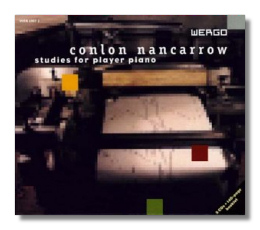
The Internet's Premier Classical Music Source
Related Links
- Nancarrow Reviews
- Latest Reviews
- More Reviews
-
By Composer
-
Collections
DVD & Blu-ray
Books
Concert Reviews
Articles/Interviews
Software
Audio
Search Amazon
Recommended Links
Site News
 CD Review
CD Review
These Studies for Player Piano may well be the first successful computer music ever composed. Begun about 1948 when Nancarrow purchased his player piano and punched rolls by hand, the project grew to about fifty pieces. You've never heard anything like them in your life.
First, they contain what have to be the 20th Century's most rapid keyboard sequences. In Study #25 glissandos and arpeggios whiz by at about 175 notes per second. One eighty-five-note figure alternates glissandos in both directions at once. Beyond a certain speed, "the ear can't distinguish the sounds the same way," says Nancarrow. "You hear the groups of notes as a block," What he revives in these studies is the tempo canon – an ancient form that takes a line of material and plays it against another version of itself at a different tempo.
Most of these studies have sections so rapid that they are impossible for a human to play on a standard piano. Such rapidity from a familiar instrument forges sound blocks that are not only technically impressive (and flawlessly performed!) but also ones that are truly bizarre. The earlier studies demonstrate Nancarrow's interest in jazz and blues, but heard from an oblique angle, as if infused with wild dreams Béla Bartók might have had. Study #7 is generously sprinkled with isorhythms, a medieval technique whereby a rhythm is several notes is repeated, going out of phase with a repeating pitch series – with different numbers of notes!
Later works grew increasingly complex, employing other techniques (like convergence points) that James Tenney painstakingly analyzes in his 58-page program notes. Upon first hearing, it seems as though this is music heard in a speakeasy from a far-off galaxy, one whose denizens received impartial radio telescopic transmissions from earth and had to fill in the gaps themselves. It is, as Horatio says in Hamlet, "wondrous strange."
Copyright © 2001, Peter Bates



















